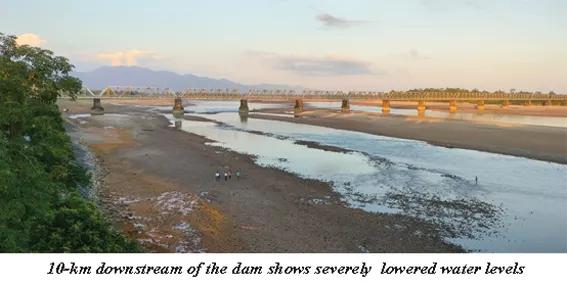ITANAGAR, 27 Oct: A landslide hit the NHPC’s 2,000 mega watt (MW) Subansiri Lower Hydroelectric Project (SLHEP), drastically reducing the flow of the Subansiri river downstream of the dam.
The NHPC stated that the landslide occurred at around 11:30 am on Friday, some 300 metres away from the dam site, blocking the only diversion tunnel in use.
According to the NHPC’s statement, “Out of the five diversion tunnels, only diversion tunnel number one was in use and has been blocked due to the landslide. The other four diversion tunnels had already been blocked earlier. As a result, the river’s flow downstream has been significantly reduced. The dam’s spillway bay level is at 145 metres above sea level. The current river flow of 997 cubic metres per second is being stored in the reservoir, and the water level reached 139 metres by 1 pm. It is expected that the water level will reach 145 metres by the evening, and the river will return to flowing through the spillway normally.”
NHPC consultant AN Mohammed, speaking to this daily, explained that the landslide had earlier blocked the four diversion tunnels, which are not currently in use as construction is almost complete. These diversion tunnels, used to redirect the river’s water during construction, are located on the left bank in Assam.
Even though the NHPC had stated that the river’s flow would return to normal, the flow remained reduced even after 7:30 pm. Experts suggest that the river may be without water from the main channel for 36-48 hours until the dam water fills the spillway. Subansiri has been hit by a series of landslides and poor construction quality, drawing the attention of the Central Electric Authority (CEA).
In April of the previous year, the powerhouse protection wall collapsed due to tail race channel construction activities of Units 1 and 2. The tail race channels, which release water back into the river after passing through turbines, are located on the right bank of the river in Arunachal Pradesh.
Over the past three years, the project site has been hit by four major landslides.
As reported earlier, in May of the previous year, the CEA had asked the developer, NHPC Ltd, to improve its construction safety measures, including reassessment of slope stability of surrounding mountains, strength of the protection wall, and workers’ safety. A team had suggested that the NHPC should reassess the impact of river diversion through the diversion tunnel on the slope stability of surrounding mountains. (https://arunachaltimes.in/index.php/2022/05/14/cea-asks-nhpc-to-reassess-slope-stability-protection-wall-improvement-in-safety-measures-in-subansiri-lower-hep/)
Repeated landslides at the site contradict the ministry of environment, forest & climate change’s (MoEFCC) claims that the project site is safe.
In 2019, the MoEFCC had written to the NHPC, stating, “The studies carried out in the thickly forested Lower Subansiri HEP reservoir indicate that the area is free from any major active landslide problem, and no significant instability condition exists in the immediate vicinity of the river.”
The NHPC began construction of the project in January 2005. However, the work was stalled from December 2011 to October 2019 due to agitations and protests by locals in downstream Assam.
According to a company estimate in January 2020, the cost of the project, originally scheduled to have been commissioned in December 2012, had escalated to around Rs 20,000 crore from the initial worth of Rs 6,285 crore. The 2,000 MW SLHEP is divided into eight units of 250 MW each.
While the project is marred by landslides, flooding, and faulty construction, the NHPC plans to operationalise 250 MW of the plant in January 2024.





